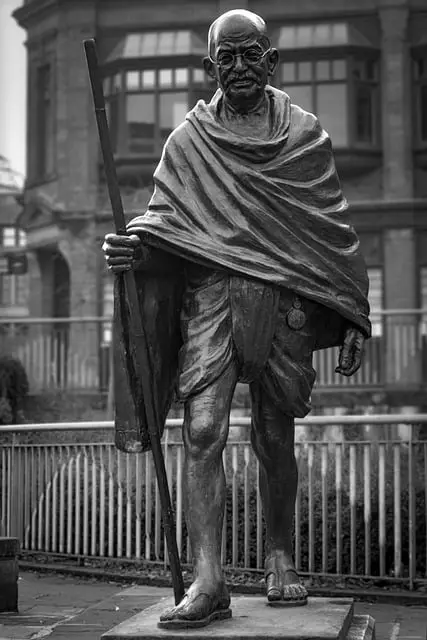October 25, 2023
We hope you enjoy our articles. Please note, we may collect a share of sales or other compensation from the links on this page. Thank you if you use our links, we really appreciate it!
Debidatta Aurobinda Mahapatra and Seema Shekhawat
How rigid othering shaped discourses on independence and division during the early decades of the 20th century, in pre-partition British India, and how it continues to shape post-partition relations between India and Pakistan? In Beyond Othering: A Gandhian Approach to Conflict Resolution in India and Pakistan, we explore this question. The clash of visions on othering and belonging led to the clash of political plans of action, which subsequently engendered the violent partition. The proponents of othering argued that two separate territories for the two cultural systems would ensure enduring peace between the two communities. Gandhi offered an alternate vision and opposed the geographical partition of British India. He attempted to address its othering through his nonviolent method. He insisted that it was the psychology of othering that engendered partition, and which persists in multiple forms and places. Following the Gandhian perspective, we have argued that othering did not lead to one partition, but instead engendered multiple partitions in the South Asian landscape and mindscape. The geographical partition that aimed to address communal differences has, in fact, largely failed to usher in peace in the region. That geographical partition happened and erected the border is a foregone conclusion, but we argue that within a Gandhian conflict resolution framework, the psychological partition that persists needs to be addressed.
The larger question is: is partition a viable solution to conflicts? There is significant literature on both sides of the spectrum on this, exploring its sanguine effects and deleterious effects. An analysis of the partition, however, does not present a very peaceful picture. The aim of this book is not to question the geographical partition, but to emphasize that the psychological othering that led to partition has persisted and manifested in multiple unsavory forms. There is a need to ameliorate its effects by promoting belonging via the application of Gandhian methods. Projected as a viable political option, the partition brought short and long-term consequences. It prompted one of the largest forced migrations in human history, the massacre of about a million people, and displacement of millions. The post-partition situation is equally dismal, as India and Pakistan have carried the legacy of psychological othering – a mirror to physical partition – like a sacred legacy. The estranged siblings have engaged in a seemingly never-ending rivalry for the last seven decades. The costs have been enormous and multifaceted, leaving no aspect of life untouched. It is necessary, therefore, to sincerely address the reality of othering for peace and development in South Asia.
The clash of visions that guided politics before independence and led to partition needs to be critically reexamined, as this clash was not just confined to the remote past. Such critical reflection would clarify, in novel ways, the persistent nature of the historic animosity that shapes the politics of the subcontinent. Major leaders, particularly Gandhi on one side, argued in favor of accommodating difference through belonging, while Iqbal and Jinnah, on the other side, argued in favor of addressing othering through geographical division. These leaders are long dead, but their ideas are still alive. It appears that the othering ideas of Jinnah and Iqbal succeeded, resulted in partition, and are still guiding South Asian politics, while the ideas of Gandhi failed to persist. An analysis of the developments of over more than seven decades suggests that othering-inspired partition did not foster peace, as envisaged by Iqbal and Jinnah. Using Comtean logic, we have argued that the present generation of political leaders and people of South Asia are still living the ideas that shaped the past. Considering this background, we have argued that Gandhian principles remain relevant, and South Asians need to cultivate Gandhian belonging in order to resolve the India-Pakistan conflict. We have made a forward-looking argument in this book and made a case to accept a belonging-inspired vision, beyond othering and partition, to promote pathways toward overcoming deep-seated hatred and animosity. There is an urgent need to address othering, psychological and cultural, which thrives in the South Asian psyche, by adopting the Gandhian way of belonging.
Can Gandhian ideas be productively used to promote belonging without compromising diverse cultural values of the communities? This crucial question has been explored in the book. We have argued that there are multiple pathways that emerge from Gandhian nonviolent praxis – some of them perhaps are yet to be discovered as they demand ingenuity, contextualization, and a deeper understanding of the evolving dynamics in the South Asian region – but they all need visionary political leadership and a national commitment to peace. Dialogues, summits, negotiations, talks, meetings, and political ceremonies, have their own value but they will not address the conflict unless they emerge from a deeper psychology of nonviolent belonging. A Gandhian would point to the failure of past summits and agreements and make a case for enabling peace emerging out of empathy and deeper understanding of each other’s positions. The past seven decades amply demonstrate that words and deeds, shaped by the psychology of othering, failed to bring desired outcome – peace. Policymakers must internalize the core message of Gandhi and accordingly craft policies. This remains an arduous task though; it would require audacity, passion, and perseverance. Did not Gandhi say, it takes courage to follow the path of nonviolence and work for peace?
Emphasizing policies to promote belonging, we have argued that psychological engagement is the fulcrum of enabling peace. We have argued that our emphasis on commonalities and their exploration is salient for addressing conflictual relations emerging from othering at other places, between the states and within the states. Instead of promoting othering, as reflected in rambunctious ceremonies like those at the Wagah border – characterized as ‘carefully choreographed contempt,’– it is necessary to craft ways to cultivate belonging. In this endeavor, the people who witnessed partition could play a prominent and inspiring role. Their heartrending stories could effectively recall the pain of othering and generate catharsis in the present generation – motivating them to think in novel ways and inaugurating a mass campaign to end violent othering. The campaign could also focus on documenting and promoting narratives of care, cooperation, and compassion. It could generate hope in younger generations for a new South Asia.
A common destiny binds India and Pakistan; a border separates them but also connects them. They share nature’s bounties in the form of rivers, flora, fauna and mountains, and nature’s fury, such as landslides, fires, and earthquakes. It is not that there has been a dearth of visionary leaders in the two countries, but it seems that the cloud of othering is so dark that the sky of opportunities is hidden from their view. The heavy historical baggage of othering pervading the cultural ethos is powerful. In the past, leaders from both the countries attempted to promote peace, but many of those attempts were marred by othering. For example, Vajpayee-Musharraf dialogue was spoiled by the Indian Parliament attack and Singh-Zardari peace moves initiatives were undermined by the Mumbai terror attack. Spoilers, the radical constituencies which do not want peace to dawn in South Asia, play a part in thwarting peace attempts. Only a vital and bold new vision and political will can thwart the trajectory set by these spoilers and prioritize a project of belonging via genuine nonviolent engagements at multiple levels. As Gandhi argued, half-hearted attempts to maximize one’s gains at the cost of exploiting the other cannot lead to conflict transcendence. And genuine engagement is possible only when political leaders act as statesmen rising above political gamesmanship and genuinely prioritize belonging in their policies.
In the book, we have raised a broad question: Can othering thrive infinitely in South Asia? If othering continues, as history stands witness, the conflict will not end, though it might see periods of stagnation. There is an increasing possibility of escalation, exacting further psychological, cultural, political, and economic costs. The political leaders, media, corporate houses, think tanks, civil society, and non-state organizations from both sides of the border must come together to play their part in promoting engagement and belonging. Such a mission, undertaken by all with a spirit of belonging is not an extravagance but a necessity. It will be a gradual process, but it will bring desired results if engineered with the right intention. The Gandhian vision of nonviolent conflict transcendence, in which othering is relegated to the dustbin of history and belonging becomes the future, when realized, will transform a violent present via a field of nonviolent praxis. While the past witnessed othering and partition, and the present carries the legacy of the past, it is not necessary that the future resembles either of these.
(Published earlier in E-International Relations: https://www.e-ir.info/2023/10/19/psychological-othering-in-south-asia-root-causes-and-pathways-for-an-enduring-solution/)



